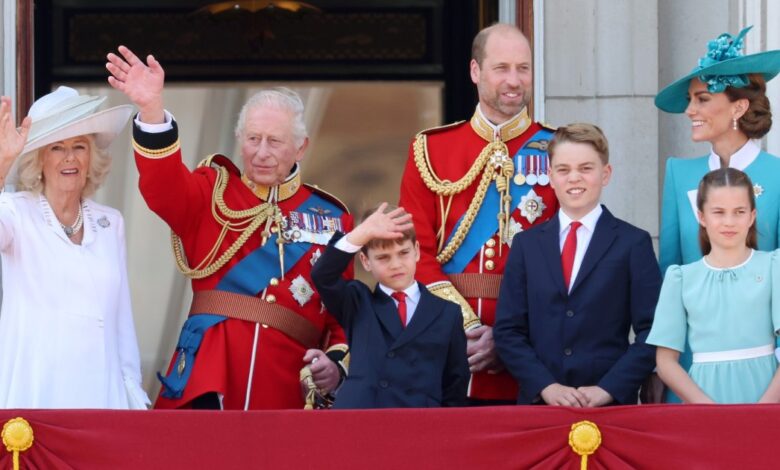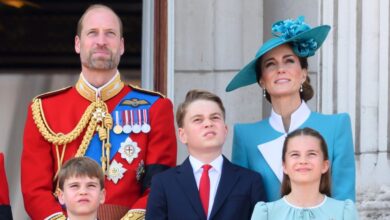Royal Kids George, Charlotte and Louis at 2025 Trooping the Colour

Prince George, Princess Charlotte, and Prince Louis stole the show at the 2025 Trooping the Colour ceremony, held on Saturday, June 14. The young royals, aged 11, 10, and 7 respectively, were accompanied by their parents, Prince William and Princess Kate Middleton, to the prestigious event. Arriving at Buckingham Palace in a carriage with their mother, the three children joined the rest of the royal family on the balcony to witness the military flypast. Prince Louis, in particular, captured hearts by mimicking his grandfather, King Charles III’s wave to the cheering crowd, while his siblings stood poised like their parents.
Dressed in navy suits with red ties, Louis and his older brother, George, twinned their outfits, while Charlotte and Kate opted for coordinating teal dresses. Prince William, following tradition, donned his military uniform, similar to his father, Charles, and other royal relatives present at the event. The balcony also saw the presence of Charles’ wife, Queen Camilla, and the monarch’s siblings, Princess Anne and Prince Edward, along with their respective spouses.
The Trooping the Colour parade, held annually in June, celebrates the monarch’s birthday, although Charles’ birthday falls in November. Over the years, George, Charlotte, and Louis have become regular attendees of the event, making their debut appearances on the Buckingham Palace balcony in 2015, 2016, and 2019, respectively. The trio have since joined other royal family members in the horse-drawn carriages that participate in the parade, with their first joint appearance occurring during Queen Elizabeth II’s Platinum Jubilee in 2022.
In a previous public outing last month on May 5, George, Charlotte, and Louis commemorated the 80th anniversary of VE Day, marking the end of World War II in Europe. The siblings, alongside William and Kate, stood on the Buckingham Palace balcony to witness a patriotic flypast and a military procession in honor of World War II veterans at the Queen Victoria Memorial.
The royal children are gradually returning to public engagements after a period of absence during Princess Kate’s cancer battle in 2024. Kate shared in September that she completed chemotherapy treatments and announced her remission in January. During her recovery, Kate made a rare appearance at Trooping the Colour in June 2024, accompanied by George, Charlotte, and Louis. The children later attended Kate’s “Together at Christmas” carol service in December 2024 with William, and the family partook in the annual Christmas Day church service in Sandringham.
In other events of 2024, William took George and Charlotte to one of Taylor Swift’s June concerts in London, Charlotte accompanied Kate to Wimbledon in July, and George enjoyed several soccer games with William.
Despite these public appearances, William, Kate, and their children have been maintaining a lower profile in recent months. Notably, they skipped the royals’ annual Easter church service at St George’s Chapel in Windsor in April, opting for a private holiday with Kate’s family instead. The couple and their kids reportedly attended church with Kate’s parents, Carole and Michael Middleton, in Sandringham, avoiding the public eye.
A source revealed that William and Kate’s absence from the Easter celebration with the royals was significant, hinting at a deliberate move and possibly even a snub. The family’s decision to spend the holiday in a more private setting reflected their desire for a quieter and more intimate time away from the public spotlight. The world of technology is constantly evolving and advancing at a rapid pace. With new innovations and developments being introduced every day, it can be difficult to keep up with the latest trends and breakthroughs. One such trend that has been gaining traction in recent years is the rise of artificial intelligence (AI).
AI is a branch of computer science that focuses on creating intelligent machines that can perform tasks that typically require human intelligence, such as understanding natural language, recognizing patterns, and learning from experience. These machines are designed to mimic human cognitive functions and are capable of performing complex tasks with great accuracy and efficiency.
One of the key applications of AI is in the field of robotics. AI-powered robots are being used in various industries, including manufacturing, healthcare, and agriculture, to perform tasks that are too dangerous or difficult for humans to do. These robots are equipped with sensors, cameras, and other technologies that allow them to navigate their environment, interact with objects, and make decisions autonomously.
In the healthcare sector, AI is being used to develop new treatments and therapies for various diseases and medical conditions. AI-powered algorithms are able to analyze large amounts of medical data and identify patterns and trends that can help doctors make more accurate diagnoses and prescribe more effective treatments. AI is also being used to develop new medical devices and technologies that can improve patient care and outcomes.
In the field of finance, AI is revolutionizing the way we manage and invest money. AI-powered algorithms are able to analyze market trends, predict stock prices, and make investment decisions in real-time. This has led to the rise of robo-advisors, which are automated investment platforms that use AI to create personalized investment portfolios for individual investors.
In the transportation sector, AI is being used to develop autonomous vehicles that can navigate roads and highways without human intervention. These vehicles are equipped with sensors, cameras, and other technologies that allow them to detect obstacles, follow traffic rules, and make decisions on the road. Autonomous vehicles have the potential to reduce accidents, increase efficiency, and improve the overall transportation experience for passengers.
Despite the numerous benefits of AI, there are also concerns about its potential impact on society. Some experts warn that AI could lead to job losses, as machines become more capable of performing tasks that were previously done by humans. There are also concerns about the ethical implications of AI, such as privacy issues, bias in algorithms, and the potential for misuse of AI technologies.
In conclusion, AI is a powerful and transformative technology that has the potential to revolutionize various industries and improve the quality of life for people around the world. However, it is important to approach the development and deployment of AI with caution and consideration for its potential impact on society. By addressing these concerns and working towards responsible AI development, we can harness the full potential of this technology and create a better future for all.





